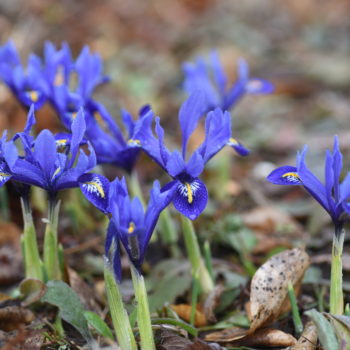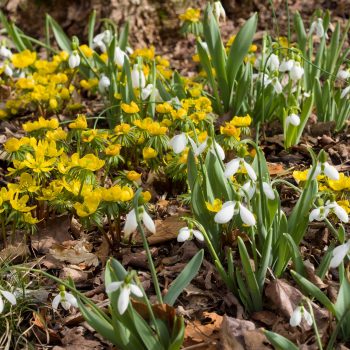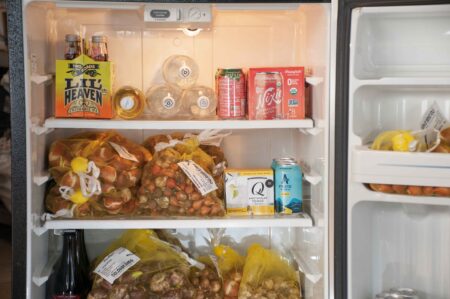
Note: This article is intended only for people in warm climates (Zones 7B–8B in the South and Southwest, and most of California).
In its broad outlines, the prechilling process is as easy as 1-2-3.
- Order your bulbs by the end of September and request delivery in October.
- Place the bulbs that require prechilling in a spare refrigerator for 6–12 weeks.
- Plant the bulbs in late fall or early winter for bloom in the spring.
Simple enough, but there is more that you need to do.
Start by Reviewing Your Bulb Needs
To perform well in warm climates, tulips, hyacinths, crocuses, and many other spring-flowering bulbs should be prechilled in a refrigerator before planting. But there are exceptions to this recommendation (see the list below). If you are planning to order only daffodils and Spanish Bluebells, for example, you can stop reading. These bulbs do not need to be prechilled. Order them for November or December delivery and plant them upon receipt.
Bulbs That Do NOT Require Prechilling
Colorblends recommends that all other bulbs be prechilled.
And what if you are looking to purchase a mix of bulbs—some that require prechilling and some that don’t? We suggest that you place two orders—one for delivery in October (the bulbs to be prechilled) and one for delivery in November or December (the bulbs that don’t need to be prechilled). If placing two orders is not practical, request delivery in October so that you can start prechilling the bulbs that need to be prechilled. Those that don’t can be planted upon receipt or stored somewhere cool and dry for a few weeks until the weather cools down (set a reminder in your phone or mark your calendar so that you don’t forget to plant them).
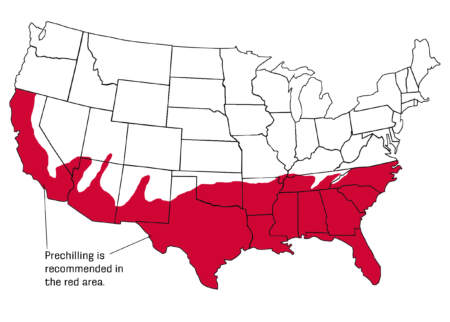
Note: Colorblends recommends against planting bulbs (prechilled or not) along the Gulf Coast and in the Desert Southwest.
Make a Schedule
There are three components to a prechilling schedule:
- The prechill interval (how long you need to prechill bulbs in your area);
- The Colorblends shipping window;
- Your desired planting time.
To determine how long to prechill bulbs, confirm that you are in a part of the country where prechilling is recommended (see map) and, if you live in the South or Southwest, find your USDA Zone. Then consult the appropriate prechill interval table. Colorblends recommends that most people planting in Zone 7b and warmer in the South and West prechill their bulbs. Please note: Colorblends recommends against planting bulbs (prechilled or not) in Zones 9–11 in the South and in the Desert Southwest.
Find your zone:
Recommended Prechill Intervals
South and Southwest |
|
| Zone | Duration |
| 7b | 6-8 weeks |
| 8a | 8-10 weeks |
| 8b | 10 weeks |
| 9a | 10-12 weeks |
| 9b | 10-12 weeks |
| 10a | 12 weeks |
| 10b | 12 weeks |
California |
|
| CA ZIP Code | Duration |
| 90XXX | 12 weeks |
| 91 | 12 weeks |
| 92 | 12 weeks |
| 93 | 12 weeks |
| 94 | 8–10 weeks |
| 95 | 10–12 weeks |
| 96 | 8–10 weeks |
After deciding how long to prechill, the next step is deciding when to take delivery of the bulbs. Colorblends starts shipping at the end of September. Temperatures in September can still be very warm. We recommend that you schedule delivery of your bulbs between mid- and late October.
Once you know how long you are going to prechill and when you are going to start, you can set your planting time.
Example: You are in Atlanta, a part of the country where prechilling is recommended. You enter your ZIP Code in the Find Your Zone box and learn that you are in Zone 8a. The recommended prechilling interval for Zone 8a is 8–10 weeks. You decide to take delivery of your bulbs in mid-October. You count out 8 weeks from your delivery week. Mid-December. You check your calendar. Aunt Betty is coming to visit for Christmas. You decide you’d prefer to plant after she leaves. You place your order and mark your calendar (or set a reminder in your phone) for planting at the end of December.
As in the above example, if your calculated planting time doesn’t suit your schedule, we suggest that you push back your planting time. In general, the longer you prechill the better. That said, we urge you to plant your bulbs no later than the middle of January.
Consider Your Fridge
Colorblends recommends against prechilling bulbs in a kitchen refrigerator. Here’s why: Bulbs are not food and have not been handled in the sanitary conditions in which food must be handled. Bulbs are bulky. If you are prechilling more than a handful, they eat up a lot of refrigerator space. Bulbs need to spend many weeks—months, in some cases—in a refrigerator before planting, tying up a lot of space for a long time. Finally, bulbs cannot be stored in a refrigerator that contains fresh produce. Many fruits and vegetables give off a gas that is harmless to people but can injure flowerbulbs.
For all of these reasons, if you are going to prechill bulbs, you should use a spare refrigerator. Many people have an extra refrigerator in the garage that they use to store soft drinks or beer. Such a refrigerator is ideal for prechilling. If you don’t have a spare refrigerator, you may want to buy one. A mini fridge might be all you need.
Calculating the amount of refrigerator space required for prechilling is tricky. Bulbs vary widely in size. A bag of 100 crocuses, for example, is about one-third the size of a bag of 100 tulips. Meanwhile, if you are using a beverage refrigerator, you need to allow room for cans and bottles, the number of which likely varies, especially around the holidays.
The type of bulb that is most commonly prechilled is tulips. As you think about the size of your refrigerator, it may help to think of a bag of 100 tulips as having the volume of a large shoebox. If you really want to work out how many bulbs you can fit, please refer to the table below.
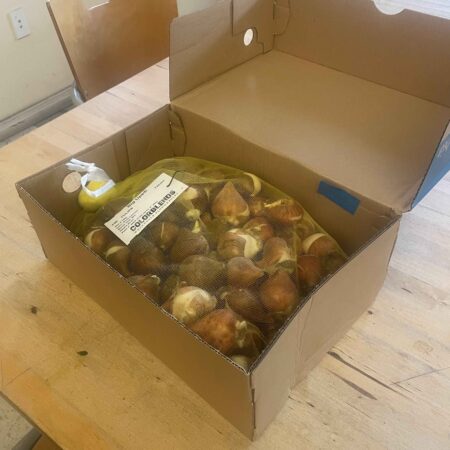
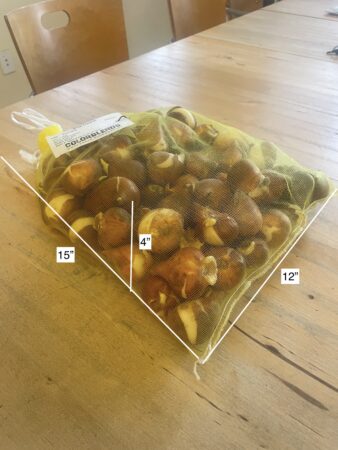
Volumes of Commonly Prechilled Bulbs
| Item | Bulbs/Bag | L x W x H (inches) |
| Aladdin’s Carpet wild tulip mix | 200 | 9 x 9 x 3 |
| Blue Squill | 100 | 6 x 9 x 2 |
| Crocus (Dutch) | 100 | 7 x 9 x 3 |
| Crocus (Tommies, Vernal Jewels) | 100 | 4 x 8 x 1 |
| Glory of the Snow | 100 | 4 x 8 x 1 |
| Grape Hyacinth | 100 | 8 x 10 x 2 |
| Hyacinth | 25 | 10 x 8 x 3 |
| Tulip, standard | 100 | 15 x 12 x 4 |
| Tulip, standard | 25 | 6 x 9 x 3 |
| Tulip, wild (variable) | 100 | 5 x 9 x 2 |
Note: Bulbs should be prechilled in the bags in which they are shipped.
There is no magic formula for determining how many bulbs you can prechill. Eyeball your refrigerator space. Think about the number of bulbs you want to plant. Then reduce the number to err on the side of too few rather than too many.
IMPORTANT: Do not put bulbs in the freezer compartment. Bulbs placed in a freezer will be killed. Prechilling should be done at normal refrigerator temperature: 35–45 degrees F.
Last thing: After placing the bulbs in the refrigerator, set a reminder in your phone or mark your calendar so that you remember to take the bulbs out and plant them.
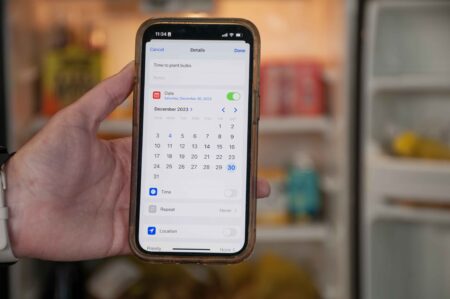
Be Quick About Planting
Planting prechilled bulbs is no different from planting bulbs that have not been prechilled, but there are additional guidelines you should follow:
- Wait to remove the bulbs from the refrigerator until you are ready to plant.
- Plant as quickly as possible after removing the bulbs from the refrigerator.
- Keep bulbs that have yet to be planted out of direct sunlight.
- If you aren’t able to plant all of your bulbs in a single session, put the unplanted bulbs back into the refrigerator until you can finish.
IMPORTANT: All bulbs must be planted in late fall or early winter—mid-January at the latest. “Prechilling” is what it says: It is the start of the chilling process. After spending time in a refrigerator, the bulbs need additional chilling in the ground to perform correctly. They need at least 8 weeks in cool, moist soil to make roots and prepare for flowering in the spring.

